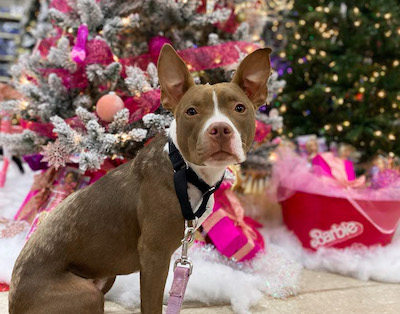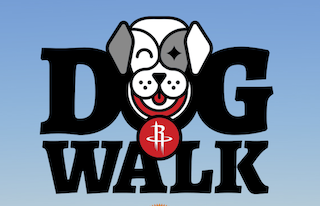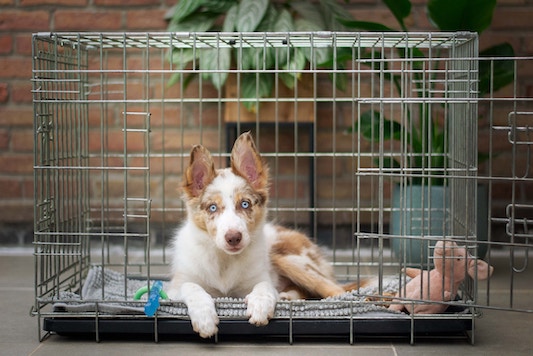“Fetch”. Based on almost any movie we’ve ever seen with a family dog in it, the dog always knows how to fetch right? Isn’t “fetching” a basic instinct for all dogs? Why doesn’t my dog get it? Even though the movies make it look natural, not all dogs are naturally interested in fetch, or tennis balls and frisbees for that matter. Some breeds such as the Labrador and Golden Retriever, German Shepherd, German Shorthaired Pointer, and Standard Poodle may have a stronger instinctual drive to pick up items. Other breeds, such as the Chihuahua, Afghan, or Shih Tzu, possibly not so much. With that being said, we’ve definitely seen a French Bulldog shag tennis balls like Serena and a Goldendoodle ignore every ball thrown by their owner. If “Fetch” is a behavior you’d like to teach your puppy, let’s start with how to get them interested.
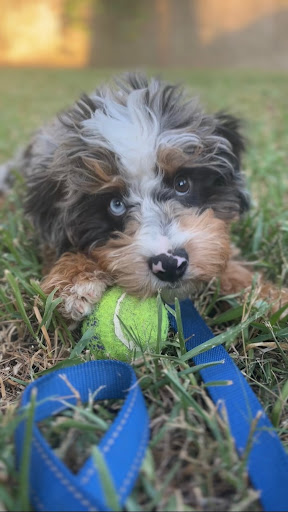
Building interest
- Keep your fetching toy exciting! Don’t leave it out in constant access for “free play” by your puppy. Keep it put up in a drawer and only use it for special play time between you and them.
- If your puppy has a chewing problem, a “tug toy” such as a rope may not be the best option to start. Instead, use a squeaky tennis ball.
- Start in your home with minimal distractions.
- Get your puppy excited about the ball, make it really fun! Squeak the ball, let them put their mouths on it and do some tugging, throw the ball against the wall over and over again. When they do put the ball in their mouth, give your puppy high praise and loads of attention!
- When you are done, place the ball back away out of sight for next time. Continue to practice this until your puppy is actively seeking out the tennis ball for play and putting it in their mouth.
Teaching fetch
Things you will need:
- 6 ft flat leash
- 2 squeaky tennis balls, Kong balls are our favorite
Trainer Tip: Choose a tennis ball that is the appropriate size for your puppy to eliminate the chance of choking.
- Start with your puppy dragging a leash so that you can keep them near you. You will want to keep your repetitions fun and quick!
- Throw the ball against the wall, but DON’T let them get the ball the first 1 or 2 throws. Build up the excitement! Then, after 1 or 2, go ahead and let your puppy get the ball.
- As soon as they put their mouth on the ball, deliver high praise and attention. When you deliver the attention, encourage your puppy to return to you with the ball.
- When they come back to you with the ball, praise and pet your puppy for a few seconds before reaching to take the ball from them.
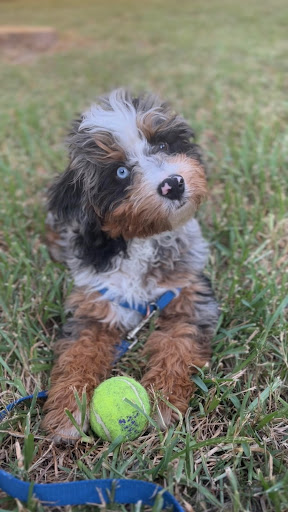
Encourage Retrieving
Retrieving is the action of going to pick up the ball, bringing the ball back to you, and then dropping the ball.
- Once your puppy is actively putting their mouth on the ball at a short distance while playing wall ball, add in your second squeaky ball.
- Move a little bit farther away from the wall so you have space, squeak Ball 1 to get your puppy’s attention.
- Toss Ball 1 against the wall and let them get the ball. When they pick up the ball, begin to praise your puppy until they get to you with that ball in their mouth.
- As soon as they get to you, squeak Ball 2 to try to encourage them to drop Ball 1.
- When they drop Ball 1, say “Out”, praise, and immediately toss Ball 2 against the wall.
- Immediately Pick up Ball 1 from the ground. Repeat this over and over again.
- If your puppy is struggling to release the ball from their mouth, take your index and middle finger into their mouth, say “Out”, and gently take the ball out of their mouth. As soon as they release the ball, deliver big praise and toss Ball 2. Repeat over and over again.
- As your puppy begins to learn the game, you should be able to start saying “Out” when they get to you, and they will begin to release the ball with just the “Out” command.
After a few days or weeks of practice, you may even find that your puppy has come to love fetch so much that they may start automatically releasing the ball for you to throw it again. You can see that we didn’t incorporate treats into this command, and you don’t need to nor do we recommend it! By following this guide, you are developing a positive association with the tennis ball that is intended to serve as its own reinforcer.
Increased motivation for the ball occurs > Ball is thrown > Ball is retrieved and brought back > Ball is thrown (Positive Reinforcement), and so on and so forth.
We want the ball to be the ultimate reinforcer in this case. When your puppy becomes really interested in the ball, you can even begin to use the tennis ball as positive reinforcement for other behaviors such as sit and come. Playing fetch can be such a great form of energy burn for puppies and a great way to make training fun! If you start training your puppy and want to learn more on how to incorporate fetch and tennis balls into other aspects of your puppy’s training, we recommend you “fetch” your local behavior consultant who can help teach you the next steps.

